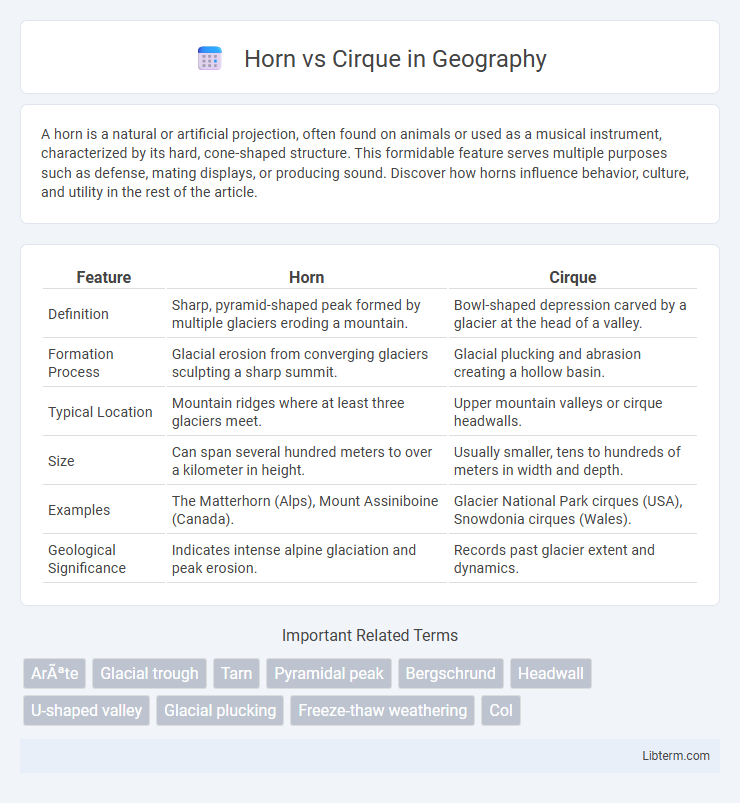A horn is a natural or artificial projection, often found on animals or used as a musical instrument, characterized by its hard, cone-shaped structure. This formidable feature serves multiple purposes such as defense, mating displays, or producing sound. Discover how horns influence behavior, culture, and utility in the rest of the article.
Table of Comparison
| Feature | Horn | Cirque |
|---|---|---|
| Definition | Sharp, pyramid-shaped peak formed by multiple glaciers eroding a mountain. | Bowl-shaped depression carved by a glacier at the head of a valley. |
| Formation Process | Glacial erosion from converging glaciers sculpting a sharp summit. | Glacial plucking and abrasion creating a hollow basin. |
| Typical Location | Mountain ridges where at least three glaciers meet. | Upper mountain valleys or cirque headwalls. |
| Size | Can span several hundred meters to over a kilometer in height. | Usually smaller, tens to hundreds of meters in width and depth. |
| Examples | The Matterhorn (Alps), Mount Assiniboine (Canada). | Glacier National Park cirques (USA), Snowdonia cirques (Wales). |
| Geological Significance | Indicates intense alpine glaciation and peak erosion. | Records past glacier extent and dynamics. |
Introduction to Horns and Cirques
Horns and cirques are key geomorphological features formed by glacial erosion in mountainous regions. A horn is a sharp, pyramid-shaped peak created when multiple cirques erode a mountain from different sides, exemplified by the Matterhorn in the Alps. Cirques are amphitheater-like hollows carved out at the heads of glaciers, serving as the starting points for glacier formation and contributing to the sculpting of alpine landscapes.
Geologic Formation Processes
A horn forms as a sharp, pyramid-shaped peak resulting from the headward erosion of multiple glaciers converging around a single massif, typically observed in alpine regions. Cirques develop through glacial plucking and abrasion, creating bowl-shaped depressions at the source zone of glaciers where ice accumulation occurs. Both landforms exemplify glacial geomorphology, with horns representing erosional isolation and cirques indicating initial ice scoop formation.
Key Differences Between Horns and Cirques
Horns are sharp, pointed mountain peaks formed by the erosion of several surrounding cirques, resulting in a pyramidal shape, while cirques are amphitheater-like hollow basins carved by glacial erosion at the head of a glacier. Horns develop where multiple glaciers erode a mountain from different sides, whereas cirques represent the accumulation zones of glaciers and serve as the starting points for glacial movement. The key differences lie in their morphology and formation processes: horns are prominent, jagged summits, whereas cirques are bowl-shaped depressions.
Physical Characteristics and Features
Horns are sharp, pyramid-shaped peaks formed by the erosion of multiple glaciers converging from different directions, creating steep, jagged summits like the Matterhorn in the Alps. Cirques are bowl-shaped, amphitheater-like depressions carved by the headwall erosion of a single glacier, characterized by their steep back walls and a flat base, often hosting glacial lakes called tarns. Horns exhibit prominent, pointed ridges, while cirques display rounded, concave hollows, highlighting distinct glacial sculpting processes.
Examples of Famous Horns Worldwide
The Matterhorn in the Alps is one of the most iconic horns, known for its sharp pyramidal peak formed by glacial erosion on multiple sides. Another famous example is the Nadelhorn in Switzerland, which exemplifies the pronounced horn shape created by the intersection of three or more cirques. These geological features illustrate how horns emerge through the intense glacial carving characteristic of high mountain environments.
Notable Cirques Around the Globe
Notable cirques such as the Cirque de Gavarnie in the French Pyrenees and the Cirque of the Towers in Wyoming showcase the dramatic glacial sculpting of mountain landscapes. These amphitheater-like valleys, carved by persistent glacial erosion, feature steep rock walls and basin floors often holding small lakes known as tarns. Iconic cirques attract mountaineers and geologists due to their unique formation processes and breathtaking natural beauty.
Role of Glacial Erosion in Formation
Glacial erosion plays a critical role in the formation of both horns and cirques by sculpting the landscape through processes like plucking and abrasion. A horn is a sharp, pyramid-shaped peak formed when multiple glaciers erode a mountain from different sides, converging to create steep ridges. Cirques are amphitheater-like hollows carved into mountainsides where glacier ice accumulates, initiating glacial erosion that deepens and widens these bowl-shaped depressions.
Ecological Significance and Habitats
Horns and cirques are distinctive glacial landforms with critical ecological significance, serving as crucial habitats for specialized alpine flora and fauna. Horns, characterized by their sharp, pyramid-shaped peaks, offer niches for cold-adapted species and act as natural windbreaks, influencing microclimates and biodiversity patterns. Cirques, amphitheater-like depressions formed by glacial erosion, often collect water to create alpine lakes that serve as habitats for unique aquatic ecosystems and support plant species that thrive in moist, sheltered environments.
Popular Activities and Tourism
Horns attract hikers and climbers seeking steep, pointed peaks with challenging ascents and panoramic summit views, popular in alpine regions like the Matterhorn in the Swiss Alps. Cirques, bowl-shaped glacial formations, are favored by tourists for scenic hiking, photography, and winter sports such as skiing in destinations like the Cirque de Gavarnie in France. Both landforms offer unique opportunities for outdoor recreation, with horns emphasizing technical climbing and cirques providing accessible trails and dramatic landscapes for sightseeing.
Preservation and Environmental Concerns
The Horn, a sharp mountain peak formed by intersecting glaciers, faces significant preservation challenges due to its fragile alpine ecosystem and increased tourist footfall causing erosion. In contrast, Cirques, bowl-shaped depressions carved by glacial activity, require protection efforts centered on maintaining their unique geomorphological features and minimizing habitat disruption for specialized flora and fauna. Both landforms demand targeted conservation strategies to address the impacts of climate change, such as glacial retreat and shifting biodiversity patterns.
Horn Infographic

 libterm.com
libterm.com